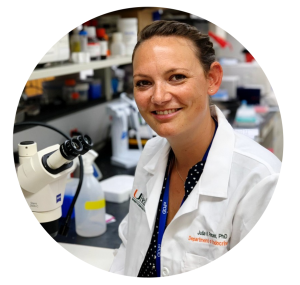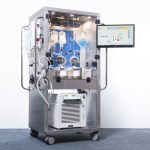
November 10th, 2022 – MIAMI – For the past 28 years, Biorep has been working closely with scientists and researchers around the world to learn more about their research and inspiration. Today, we are pleased to share with you our latest interview with Julia Panzer, PhD.
Dr. Julia Panzer is a Postdoctoral Research Fellow in the Department of Medicine at the University of Miami Miller School of Medicine in the laboratory of Dr. Alejandro Caicedo. During her doctoral studies she established and implemented the human slice platform to study islets in their native environment. As a postdoctoral fellow, she is using the tissue slices to investigate islet cell function and interaction with their microenvironment. Julia recently obtained a three-year ADA postdoctoral fellowship to study alpha cell dysfunction during type 1 diabetes and whether it can be restored if paracrine signaling pathways are restored pharmacologically.
Please tell us about your background and how you became a leading researcher at University of Miami.
I initially trained as a food chemist in Germany, with a special focus on toxicology and biochemistry. After graduating, I expanded my skills and deepened my knowledge in the field of environmental carcinogenesis in a research lab at King’s College London, UK. The insights I obtained inspired me to transition to the field of molecular biology, so I joined the lab of Dr. Rink investigating cellular regeneration at the Max Planck Institute Dresden, Germany. Later, as a Ph.D. student in the lab of Professor Speier, I discovered my passion for islet cell physiology and understanding the complex function and interplay of pancreatic endocrine cells with their local environment. During my Ph.D., I implemented a technique for generating human pancreas tissue slices to conserve the anatomical environment for 3D analysis of living endocrine cells. This technique allows studying the functional responses of human islets under near physiological conditions and is now considered as a new promising approach for the study towards a successful therapy of type 1 diabetes. The Network for Pancreatic Organ Donors (nPOD) in Gainesville, Florida recognized this technique as a valuable tool and thus invited me to help implement the slice technique within nPOD. Thanks to this effort, human pancreatic slices are now routinely shipped to investigators throughout the United States for their studies on diabetes. Due to this valuable collaboration with multiple research labs, I finally found my way to the lab of Professor Caicedo, where I work as a postdoctoral fellow on a 3-year award from the American Diabetes Association.
What type of research is being advanced at Dr. Caicedo’s lab?
Our research group investigates the anatomy and physiology of the pancreatic islet. Endocrine cells form cell collectives we call islets which secrete hormones that help regulate glucose metabolism. Not only are endocrine cells instructed to be close to each other, but they also establish numerous channels of communication with their neighbors. In our lab we study these interactions between the individual cells of the islet but also with nerves, blood vessels, and local immune cells in their microenvironment. We use the tissue slice technique to study islet physiology during health and disease.
I am working on two different projects. My main project focuses on alpha cell dysfunction in type 1 diabetes. The alpha cell within the pancreatic islet is important to counteract life threatening hypoglycemia. My goal is to understand the role of paracrine signaling in the alpha cell in the steady state and how beta cell loss (and thus paracrine input to the alpha cell) leads to loss of glycemic control. Specifically, I am interested in whether alpha cell function can be rescued if paracrine signaling pathways are restored pharmacologically which can be targeted in a clinical setting. I also study the development of the pancreas, specifically the signals within the islet environment that are necessary for endocrine cell maturation in mouse and human tissues.
Why have you chosen to focus on helping find a cure for diabetes?
Diabetes is a metabolic disease representing one of the most prevalent conditions affecting human health in the 21st century. Finding possible targets to develop novel therapy options for this disease fulfills my scientific passion and curiosity.
What are the challenges intrinsic to Type 1 and Type 2 diabetes research and how is your research helping the field get closer to a biological cure?
One of the many challenges our research community is facing is to translate our findings to the human situation. Functional analysis of pancreatic islets can only be performed to a very limited extent in vivo. Consequently, most of our knowledge regarding diabetes pathogenesis is derived from mouse models and limited studies on human pancreas biopsies. While many important insights were obtained from these efforts, they only represent a snapshot of the acute situation rather than disease progression. Results obtained from mice are often hard to translate. To allow more systematic studies of human pancreatic tissue, initiatives such as the Network for Pancreatic Organ donors with Diabetes (nPOD), the Integrated Islet Distribution Program (IIDP), and the Human Pancreas Analysis Program (HPAP) have been established to collect tissues from organ donors. These programs will help tremendously in advancing our understanding of diabetes disease progression and developing new therapeutic treatments.
What are the advantages of working with pancreas slices vs individual islets?
Traditionally, endocrine cell physiology has been studied in isolated islets. These efforts have significantly improved our understanding of islet function. However, isolated islets suffer from preparation-induced stress that may change their physiological properties and bias analyses toward the most resilient islets that survive the isolation procedure. By using the tissue slice technique, we circumvent these limitations. The slice platform enables the in-situ study of pancreatic endocrine and exocrine cell physiology in a conserved environment. This is particularly advantageous for studying infiltrated and structurally damaged islets as found in type 1 diabetes. More importantly, this technique can help us elucidate how islets interact with other cells in pancreatic regions bordering the islet i.e., blood vessels, immune cells, or nerves. This approach allows to study specific drug targeting within the microenvironment of the islet instead of focusing on the islet as an isolated unit. However, the tissue slice platform also has its limitations and was never intended to replace any existing technique. It represents a complementary approach that will help us understand pancreas function in health and disease.
Do you think the concept of slices can be expanded to other aspects of research (i.e brain slices, heart slices, cancer tumor slices, etc)?
Certainly. The concept of the tissue slice technique is not new. It was established for multiple types of tissue already decades ago. Because tissue architecture and cell-to-cell communication remain intact, slices are used routinely to study electrical properties of neurons in the brain or to investigate injury and disease progression in the liver. For the pancreas, however, the slice platform is relatively new, and we are still establishing and optimizing functional assays to improve their application. I do think the technique can be expanded beyond studying basic pancreas function to investigate changes induced by pancreatic cancer or pancreatitis.
What are the trends in the diabetes research industry?
Although there are several trends, I would say that the research field is moving away from animal models due to the availability of human tissue and technological advances that allow us to do more translational research. We will still need animal models to answer deeper mechanistic questions, but most research papers now require some type of confirmation with human samples. Slices are certainly a trend in our field as evidenced by the increased demand, but I wouldn’t call them yet a generalized trend in the diabetes research industry.
University of Miami has a close relationship with the Biorep. Please tell us about the value of this collaboration.
We are fortunate to work very closely with the bright minds of multiple engineers at Biorep. Due to the structure and size of the slices we had to optimize existing tools established for isolated islets. Together with Biorep we were able to create necessary equipment that enable functional readouts using the tissue slices. This made the experimental setups not only easier but measurements more precise and reproduceable.
An important instrument for islet physiology labs worldwide is the Biorep Perifusion System designed for isolated islets. Thanks to our close relationship with Biorep we now produced specific pancreas slice chambers that can be easily connected to their machine and provide precise hormone measurements of endocrine as well as exocrine cells. Collaborations with companies like Biorep are very important for the research community, as they allow us to create novel tools for experimental needs. In the case of the slices, this collaboration improved functional readouts and allows prolonged tissue integrity and viability. We continue working closely together with Biorep creating devices for islet culture and shipment.
To learn more about Dr. Julia Panzer’s research, see these papers:
Panzer JK, Tamayo A, Caicedo A. Restoring glutamate receptor signaling in pancreatic alpha cells rescues glucagon responses in type 1 diabetes. bioRxiv 2021.08.11.455935; doi: https://doi.org/10.1101/2021.08.11.455935
Panzer JK and Caicedo A. Targeting the pancreatic alpha cell to prevent hypoglycemia in type 1 diabetes. Review paper. Diabetes. 2021 Dec;70(12):2721-2732. doi: 10.2337/dbi20-0048.PMID: 34872936
Panzer JK, Cohrs CM, Speier S. Using Pancreas Tissue Slices for the Study of Islet Physiology. Methods Mol Biol. 2020;2128:301-312. doi:10.1007/978-1-0716-0385-7_20. PMID: 32180201.
Qadir MMF, Álvarez-Cubela S, Weitz J, Panzer JK, Klein D, Moreno-Hernández Y, Cechin S, Tamayo A, Almaça J, Hiller H, Beery M, Kusmartseva I, Atkinson M, Speier S, Ricordi C, Pugliese A, Caicedo A, Fraker CA, Pastori RL, Domínguez-Bendala J. Long-term culture of human pancreatic slices as a model to study real-time islet regeneration. Nat Commun. 2020 Jun 29;11(1):3265. doi:10.1038/s41467-020-17040-8. Erratum in: Nat Commun. 2020 Jul 22;11(1):3742.PMID: 32601271; PMCID: PMC7324563.
Cohrs CM, Panzer JK, Drotar DM, Enos SJ, Kipke N, Chen C, Bozsak R, Schöniger E, Ehehalt F, Distler M, Brennand A, Bornstein SR, Weitz J, Solimena M, Speier S. Dysfunction of Persisting β Cells Is a Key Feature of Early Type 2 Diabetes Pathogenesis. Cell Rep. 2020 Apr 7;31(1):107469. doi: 10.1016/j.celrep.2020.03.033. PMID: 32268101.
Panzer JK, Hiller H, Cohrs CM, Almaça J, Enos SJ, Beery M, Cechin S, Drotar DM, Weitz JR, Santini J, Huber MK, Muhammad Fahd Qadir M, Pastori RL, Domínguez-Bendala J, Phelps EA, Atkinson MA, Pugliese A, Caicedo A, Kusmartseva I, Speier S. Pancreas tissue slices from organ donors enable in situ analysis of type 1 diabetes pathogenesis. JCI Insight. 2020 Apr 23;5(8):e134525. doi:10.1172/jci.insight.134525. PMID: 32324170; PMCID: PMC7205437.
To learn more about the Pancreas Slice Chambers for perifusion studies, click here.
If you are interested in being selected for a Researcher Spotlight newsletter and Q&A blog, please contact us at info@biorep.com


